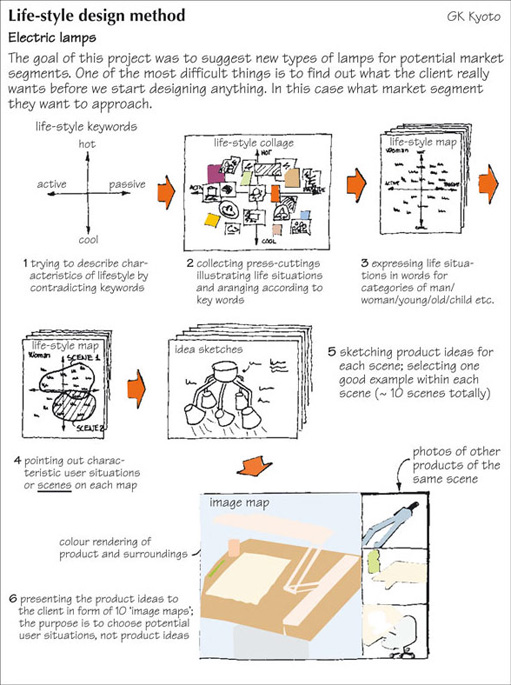13 Products for markets
Japanese car companies came to dominate in many countries in the 1980s, and this was in part attributable to their marketing research and emphasis on designing products for particular market segments. An example is the car firm Nissan, which researches national preferences for various car attributes in different countries. For instance, it is reputed to have provided its cars with softer suspensions in Germany, firmer steering in the UK, and noisier exhausts in Italy. There are other reasons for the success of Japanese companies, such as their product quality and reliability, but an approach of lifestyle analysis has been used widely by Japanese companies to design products for markets.
For example, the lifestyle design method has been used by the GK-Kyoto company (Figure 13). This method uses lifestyle collages – paste-ups of pictures of people, products, situations, and so on, that reflect a particular lifestyle; designers sometimes call these mood boards (another example of the use of these boards can be seen on the Phillips video clip). Here, the boards present formal lifestyle ‘maps’ of typical life situations, based on contrasting key-words or images of lifestyle.

From these lifestyle maps, characteristic user situations are identified for which there may be new product opportunities. Consideration of these user situations or scenarios, perhaps in creative brainstorming sessions with designers and/or users can lead to product ideas. Images of these potential products in their use situations are then created before finally deciding on a product to develop through to marketing tests.
Companies use market research to identify different market segments, and provide a range of differentiated products to appeal to different consumers within these market segments. This is market segmentation and product differentiation. Techniques such as focus groups and surveys are used in market research to capture the voice of the customer – meaning comments and opinions that influence consumer choice and that need to be taken into account in product planning and design. Other techniques include analysis of consumer lifestyles or ‘kansei engineering’ approaches to identify areas for product improvement or suggest opportunities for the development of new products.
Click on the 'View document' link below to read: 'Kansei Engineering'.
View document [Tip: hold Ctrl and click a link to open it in a new tab. (Hide tip)]
